Energy is seen as a significant factor in economic growth and a major agent in the production of wealth. The depletion of fossil fuels and the environmental problems they generate have highlighted the need for new sustainable energy supply options that make use of renewable resources. energies.
Systems for producing solar thermal electricity, often known as solar thermal power, can be developed as a potential source of power in the future. Emerging technologies for renewable energy, such as STE-producing systems,
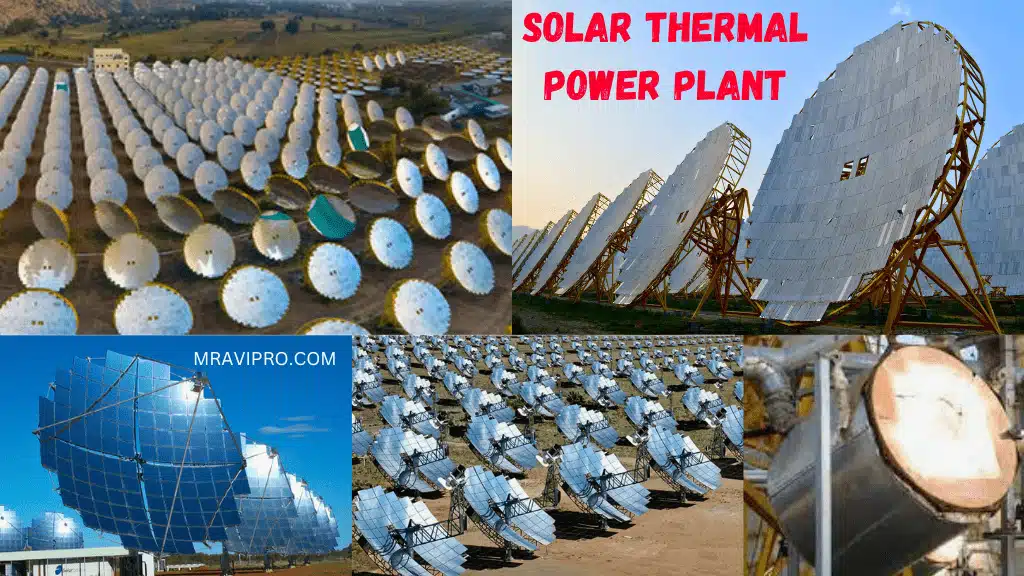
The possibilities and challenges for establishing solar thermal power plants with regard to India are examined in this essay, along with the available technology options and their current condition.
India’s Power Scenario
India currently has an installed capacity of 135,401.63 MW of power. There is currently a 7.5% overall power shortage and a 10% peak power shortage.
The 11th Plan’s goal is to add 100,000 MW by 2012, and MNRE has set a goal of adding 14,500 MW from new and renewable energy sources by 2012, of which 50 MW would come from solar energy.
By 2030, India’s Integrated Energy Strategy projects an installed capacity for power generation of 800,000 MW, with a significant share coming from renewable sources.
This suggests that India’s energy needs in the future will be very high, and solar energy can be one of the most effective and environmentally responsible solutions to meet those needs.
Solar energy potential
India receives a lot of radiant energy from the sun because it is situated in the equatorial sun belt of the planet.
A statewide network of radiation stations that monitor solar radiation and the amount of sunshine each day is maintained by the India Meteorological Department.
250–300 days a year are spent in clear, sunny weather throughout the majority of India. The range of annual global radiation, which is comparable to radiation experienced in tropical and subtropical climates, is 1600 to 2200 kWh/m2.
Around 6,000 million GWh of energy per year are contained in the equivalent energy potential. Figure 1 displays a map of India with information on the country’s various regions’ solar radiation levels.
Although Rajasthan, northern Gujarat, and parts of the Ladakh region receive the highest annual global radiation, Andhra Pradesh, Maharashtra, and Madhya Pradesh also receive a sizable amount of radiation Compared to a lot of other parts of the world,
especially in Japan, Europe, and the US, where the development and deployment of solar technologies are at their highest.
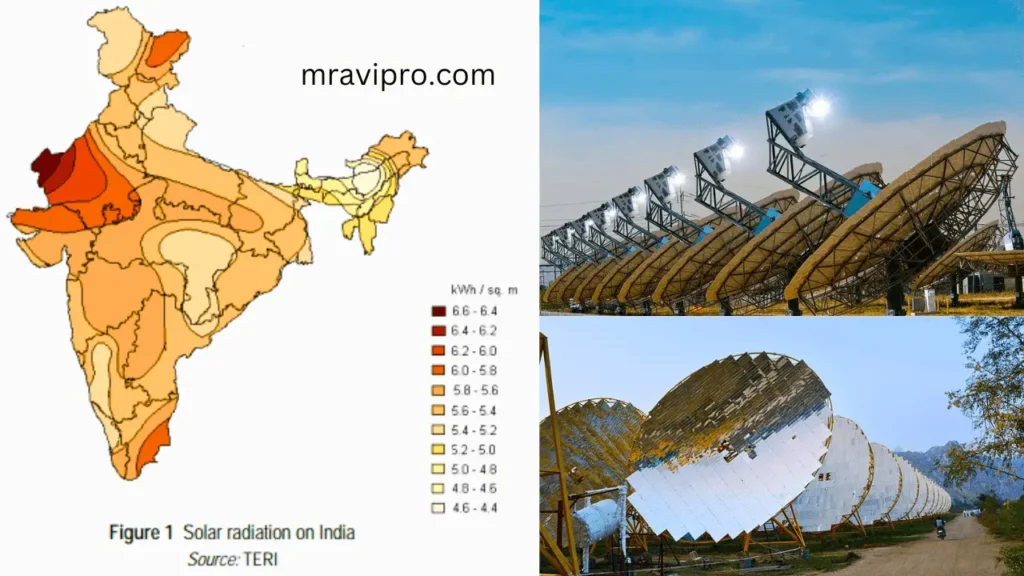
Solar thermal power generation technologies
Solar thermal power systems, sometimes referred to as concentrating solar power systems, generate electricity through the thermal process by using concentrated solar radiation as a high-temperature energy source.
Concentrating collectors are utilized for these applications because the average working temperature of stationary non-concentrating collectors is low (maximum up to 1200 C) in comparison to the desired input temperatures of heat engines (above 3000 C).
These technologies are suitable for uses where there is a lot of direct sun radiation. With the exception of using solar energy as a source of heat, the technique of turning solar energy into electricity is fundamentally identical to that of conventional thermal power plants.
In the fundamental process of converting solar energy into heat, incident solar irradiance is collected and concentrated by concentrating solar collectors or mirrors, and the generated heat is used to heat thermic fluids like heat transfer oils, air, water, or steam, depending on the plant design, as a heat carrier and/or as a storage medium.
A heat engine is run by hot thermic fluid that has been utilized to generate steam or hot gases. In these systems, the efficiency of the heat engine increases with an increase in operating temperature, whereas the efficiency of the collector somewhat decreases as the running temperature rises.
Concentrating solar collectors
Heat is generated from solar energy using solar collectors. Three main types of high-temperature solar energy collectors exist:
- Parabolic trough system: At the receiver, it can reach 400°C and produce steam for generating electricity.
- Power tower system: Always directed at the receiver, where temperatures considerably above 1000° C are possible, are the sun’s reflected rays.
- Parabolic dish systems: The highest-efficiency systems for converting solar energy to electricity are parabolic dish systems, which may reach temperatures of 1000° C at the receiver.
Parabolic trough collector system
Line-focusing STE (solar thermal electric) generating plants are parabolic trough plants.
Trough methods concentrate direct solar radiation onto an absorber pipe that runs along the parabola’s focal line using the mirrored surface of a linear parabolic concentrator.
The steam generator, which is coupled with a steam turbine, receives hot heat transfer fluid (HTF) from the absorber pipe. When there is not enough sunlight, it is typically necessary to make steam using a natural gas burner.
The collectors revolve around horizontal north-south axes, a configuration that slightly reduces the amount of energy incident on them throughout the year but favors operation during the summer when peak power is required.
The system’s primary parts are the controllers, fluid transfer pumps, power generation systems, and collectors. The condenser cooling water is chilled in forced draft cooling towers, and the power generation system typically comprises a normal Rankine cycle reheat turbine with feedwater heaters, deaerators, etc.
These kinds of power plants are capable of having energy storage systems that include the collectors mentioned above. Instead, they have become a couple.
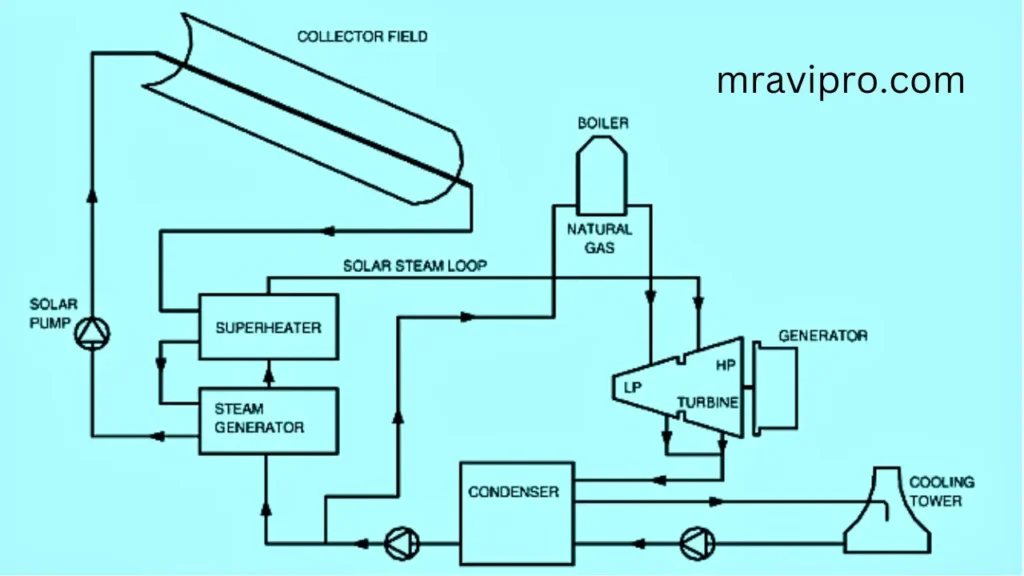
In the 1980s, California in the US saw the commercialization of these systems. Between 1980 and 1989, the LUZ Corporation built nine of these facilities, with a combined 350 MWe capacity. SEGS is the common name for these plants (solar electric generator systems). Oil is used by SEGS to remove heat, and after passing through a heat exchanger, the oil creates steam that powers a steam turbine (Figure 3).

In addition to component and material research and development, two significant technological advancements are currently underway: 1. the integration of parabolic trough power plants into combined cycle plants; and 2.
direct steam generation in the absorber tubes of collectors. The HTF and water heat exchangers will no longer be necessary when using direct solar steam generation, which improves efficiency conditions and raises cycle efficiency overall.
Another example of this technology is the SSPS-DCS plant owned and operated by Plataforma Solar de Almera in Spain.
Power tower system
In power tower systems, heliostats reflect and concentrate sunlight onto a central tower-mounted receiver, where the energy is transferred to an HTF. A heliostat is a device that tracks the movement of the sun and is used to orient a mirror or field of mirrors throughout the day, to reflect sunlight onto a target receiver.
The thermal energy is subsequently transferred to storage or power-conversion units, which turn it into electricity. The main parts of the system are the heliostat field, the heliostat controls, the receiver, the storage system, and the heat engine, which powers the generator.
When utilized with Rankine cycle engines, a cylindrical receiver has benefits for a large heliostat field, especially for radiation from heliostats at the field’s outer edges.
For the higher temperatures needed for the functioning of Brayton cycle turbines, cavity receivers with bigger tower height to heliostat field area ratios are used (Figure 4).
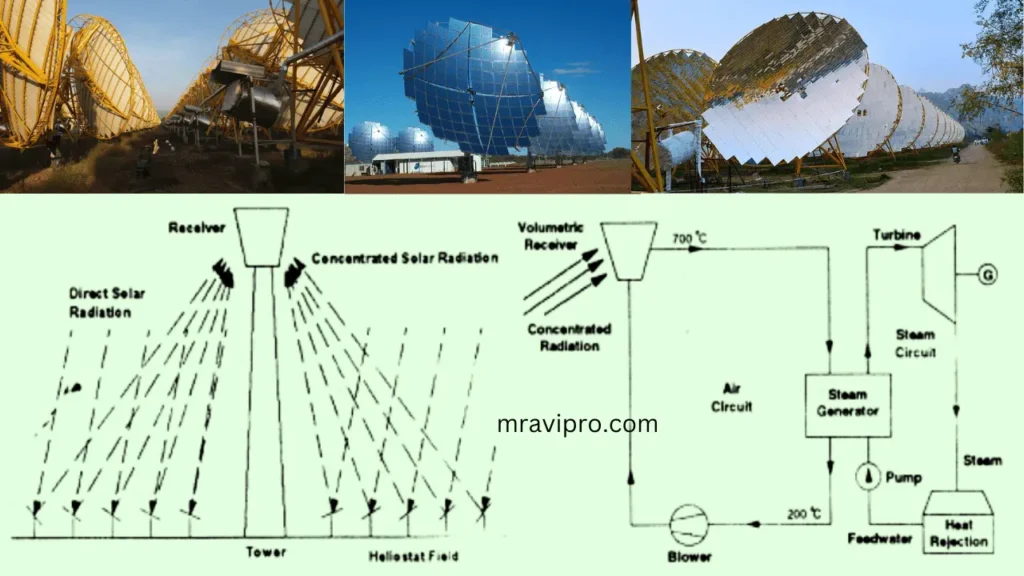
The parameters selected for an HTF, the thermal storage medium, and the power conversion cycle define these plants. HTF can be made of water or steam, molten nitrate salt, liquid metals, or air, and PCM can provide thermal storage (phase change materials).
Power tower systems may function at temperatures as high as 1500 °C and often attain concentration ratios of 300 to 1500. Two methods can be utilized to maintain constant steam characteristics even under fluctuating solar irradiation:
- ƒ Integration of a fossil backup burner; or
- ƒ Utilization of thermal storage as a buffer
Even when solar radiation is not available, electricity can still be produced by using thermal storage to store heat for a short period of time. Modern research and development have concentrated on stretched-membrane heliostats and polymer reflectors.
Two thin metal membranes are stretched across a metal ring to form a stretched-membrane heliostat. A focus control mechanism modifies the front’s curvature.
By changing the pressure in the plenum between the two membranes, a silvered-polymer reflector is laminated with a membrane. The now-decommissioned 10-MW Solar One and Solar Two demonstration facilities in the Mojave Desert served as examples of heliostat-based power plants.
These initiatives are expanded upon by the 15 MW Solar Triple Power Tower in Spain. The 11 MW PS10 Solar Power Tower was just finished in Spain. A solar power station with 4,000–5,000 heliostat mirrors, each with a 140 m2 surface area, is planned for South Africa.
Parabolic dish system
The parabolic dish system concentrates sunlight onto receivers placed at the focal point of the dish, which collects the energy and transforms it into thermal energy, using a parabolic dish-shaped mirror or a modular mirror system that resembles a parabola and features two-axis tracking.
This can be utilized right away to generate heat for thermal applications. A local generator connected to the receiver can either convert the thermal energy directly into electricity or transmit it to a central generator for conversion (Figure 5).
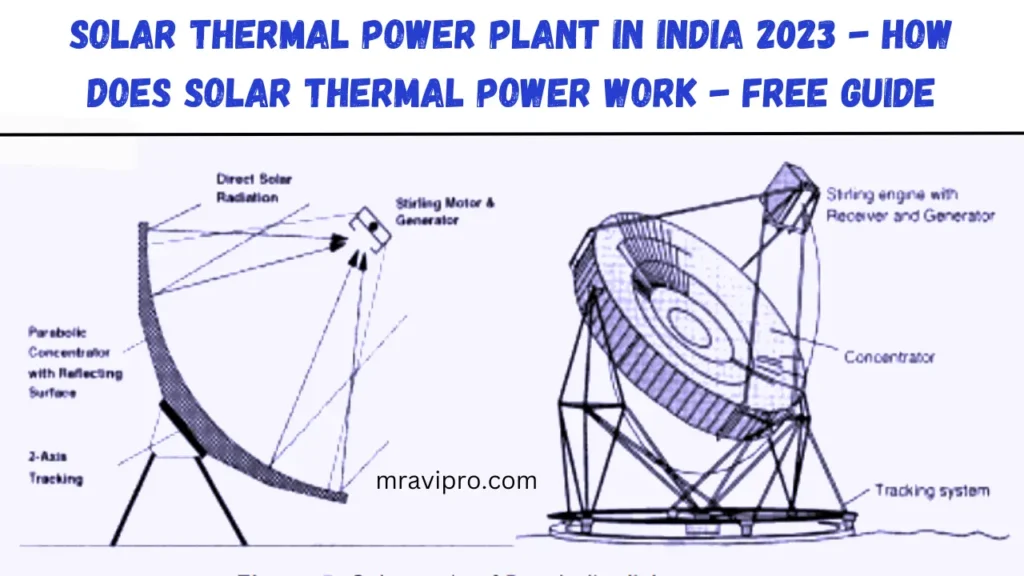
The mirror system is often constructed from a number of mirror facets, either made of glass or polymer, but it can also be a single stretched membrane composed of thin metal or a polymer mirror.
The most effective collector systems are PDCs (parabolic dish collectors), which follow the sun on two axes. They can reach temperatures of more than 1500 °C, and their concentration ratios typically vary from 600 to 2000.
For systems utilizing dish-mounted engines, Rankine-cycle engines, Brayton-cycle engines, and sodium-heat engines have been taken into consideration. The Stirling-engine systems, however, received the most focus.
Creating a power-conversion unit with low initial and ongoing expenses, a long lifespan, high conversion efficiency, and autonomous operation is the major difficulty facing distributed-dish systems.
Although a variety of engines, including gas turbines, reciprocating steam engines, and organic Rankine engines, have been investigated, Stirling-cycle engines have recently received the majority of the spotlight. These piston engines have an external heat source that continuously adds heat to a closed-loop gas, often hydrogen or helium, at high pressure.
The Great Dish in Canberra, Australia, and the Stirling Energy Systems (SES) and Science Applications International Corporation (SAIC) dishes at UNLV are examples of this technology. Technical information on several solar thermal power facilities that are now operational worldwide is presented in Annexure I.
Solar chimney
This idea is quite straightforward. According to Figure 3.0, the solar chimney has a tall, glass-covered chimney in the middle of the field. Because of the density differential between the slightly cooler air outside the upper end of the tower and the hotter air inside, hot air produced by the solar heat is passed through the center tower to reach its upper end. This air drives wind turbines inside the tower as it ascends. These systems were anticipated to be less expensive and require substantially fewer components.
This technique was difficult to use because of its low operational efficiency and the requirement for a large tower with a height of at least 1000 meters. To test the idea, a pilot solar chimney project was set up in Spain.
The picture of this plant, which has a 50 kW capacity, is shown in Figure 6 and was successfully run between 1982 and 1983. The Australian company EnviroMission Limited recently began construction on the first of its five solar chimney-based projects in Australia.
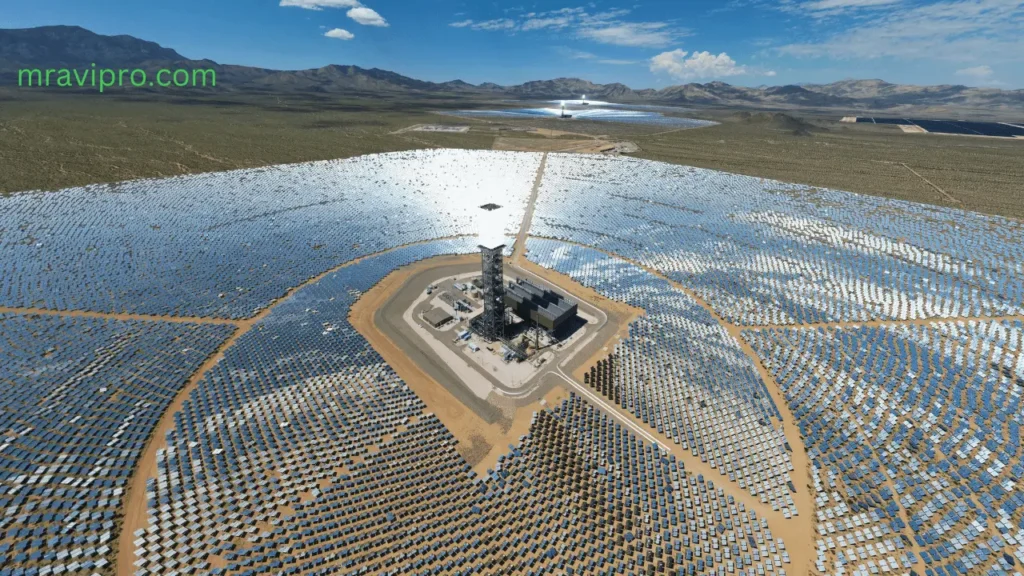
A significant setback for the advancement of solar thermal power technology occurred in the 1990s when The Luz Company, which pioneered parabolic trough collector-based solar thermal power technology, went out of business.
The solar thermal power generation program of India
The first 50 kW solar thermal power plant in India was built by MNES at Gwalpahari, Gurgaon, using the parabolic trough collector technique (line focusing). It was commissioned in 1989 and ran until 1990, when it was shut down for a lack of replacement parts. With the development of components like mirrors and tracking systems, the facility is being revitalized.
The Rajasthani government has approved a proposal for a 140-megawatt solar thermal power plant to be built at Mathania. The GEF has granted a grant of US$40 million for the 140 MW Integrated Solar Combined Cycle Power Station project, which includes a 105 MW conventional power component and a 105 MW solar power generating system.
The German government has decided to fund the project with a DM 133.2 million commercial loan and a DM 116.8 million soft credit.
A commercial power plant based on solar chimney technology was also researched in Rajasthan’s northwestern region. Five phases were to be used to implement the project.
The power output will start at 1.75 MW in the first stage and increase to 35 MW, 70 MW, 126.3 MW, and 200 MW in the following stages.
The solar chimney will progressively rise from its initial height of 300 meters to its final height of 1000 meters. It is anticipated that the cost of power from this facility will be Rs. 2.25/kWh. However, the initiative was abandoned for security and other reasons.
A solar dish-based power plant was constructed in the 1990s by BHEL Ltd., an Indian power equipment manufacturer, as part of the ministry’s research and development initiative at the time.
The US government contributed to the project’s funding. On this plant, there were six dishes. In the 1990s, a few governments, including Gujarat and Andhra Pradesh, performed feasibility studies for solar thermal generating facilities. Later on, though, not much work was done.
Possibilities for the production of solar thermal energy in India
The production of solar thermal energy can be a substantial contributor to closing the electricity supply-demand imbalance. There are three possible kinds of applications.
- Rural electrification using solar dish collector technology
- These dishes typically have a 10 to 25 kW capacity each, and they generate their power using stirring engines. They can be used with biomass gasifiers for the production of hot air to create distributed generation at the village level.
- integration of current industries, such as the paper, dairy, or sugar sectors, which have cogeneration units, with solar thermal power plants. Steam turbine systems are used in several industries for cogeneration. They can be connected to solar thermal energy facilities. These units typically have capacities between 5 and 250 MW and can be connected to solar thermal power facilities. This strategy will lower the capital expenditure on steam turbines and related power-house equipment, lowering the cost of producing solar electricity as a result.
- combining existing coal-fired power facilities with solar thermal power-producing units. The study demonstrates that savings of up to 24% are feasible for feed water heating to 241 °C during times of high insolation (4).
Barriers
In-depth feasibility studies, technology identification, and accurate assessments of the solar radiation resource are required for solar thermal power facilities. In the context of India, it is unclear how overseas technology is now faring in terms of availability, financial viability, and commercial viability. The lengthy process of developing the technology for the Mathania plant has given the technology a bad reputation.
Way ahead
In many regions of the world, solar thermal power generation is once again a financially feasible technology. To evaluate the most recent technology and its viability in the Indian context, India must take fresh action.
These projects are eligible for CDM benefits, and given India’s high amounts of solar radiation, SE plants may soon be economically viable.
To investigate these technologies and create feasibility studies for appropriate applications, the MNRE and SEC (Solar Energy Center) should take the lead. These investigations can be undertaken by renowned research institutions like TERI.
- Also, Read This Article:- How Long Does a Car Battery Last
- Also, Read This Article:- 4s Lipo Battery Full Details and Problem Solution
- Also, Read This Article:- 12V 7Ah Battery Charger Circuit Diagram
- Also, Read This Article:- 3.7Volt Li-ion Battery Charger Full Details & Solution.
- Also, Read This Article:- new transparent monitor
Conclusion
The fundamental criteria for project evaluation are resource assessment, technological suitability, and financial viability. There is enough solar radiation accessible across the
country. Worldwide, solar tower power and point-focusing dish types of plants are becoming increasingly common. The pulp and paper business needs a moderate temperature for processing, and solar energy is an efficient way to produce that temperature. The use of solar energy-based power generation systems can significantly contribute to meeting the energy needs of industry.
Bibliography
- Ministry of New and Renewable Energy Sources Annual Report, 2005–2006.
- Beerbaum B. and G. Weinreb, Solar thermal power generation in India: a techno-economic analysis, Renewable Energy, 21, 2, 2000, 153–174.
- Duffie J.A., Beckman W.A. Solar engineering of thermal processes. New York: Wiley; 1991.
- Kalogirou S. A., Solar thermal collectors and applications, Progress in Energy and Combustion Science, 30, 3, 2004, 231-295.
- Kreith F., Kreider J.F., Solar Engineering Principles, 1978, New York: McGraw-Hill.
- Winter, C. J., R. L. Sizmann and L.L. Solar Power Plants: Foundations, Technology, and System Economics, Vant-Hull, Springer-Verlag, New York, USA
- Status Report on Solar Thermal Power Plants by Pilkington Solar International, Germany
- National Renewable Energy Laboratory (USDOE), USA
What is a solar thermal power plant?
A solar thermal power plant is a facility that uses the sun’s energy to generate electricity. It has two main components: mirrors that reflect and concentrate sunlight onto a receiver, and a heat-transfer fluid that converts the solar heat into steam. The steam then drives a turbine and a generator to produce electricity. Solar thermal power plants can also store heat in molten salt or other materials for later use.
What are the advantages of solar thermal power plants?
Solar thermal power plants are facilities that use the sun’s energy to produce electricity. They have several advantages, such as:
They are renewable and do not depend on fossil fuels that can run out or cause pollution.
They can store heat in molten salt tanks and provide electricity even when there is no sunlight.
They can operate at high temperatures and efficiencies, reducing the cost of power generation.
Solar thermal power plants use mirrors or lenses to concentrate sunlight
onto a receiver that contains fluid. The fluid is heated by the sun and turns into steam, which drives a turbine and a generator.
disadvantages of solar thermal power plants?
Solar thermal power plants are facilities that use the sun’s heat to generate electricity. They have some advantages, such as being renewable, non-polluting, and low maintenance. However, they also have some disadvantages, such as being expensive, inconsistent, and difficult to store. Here are some of the drawbacks of solar thermal power plants:
Expensive equipment cost: Solar thermal power plants require large areas for installation and complex systems of mirrors, receivers, and fluids. They are more expensive than other power stations, such as solar photovoltaic plants.
Inconsistent energy production: Solar thermal power plants depend on the availability of sunlight, which varies with weather, season, and time of day. They cannot produce energy at night or on cloudy days unless they have backup storage systems.
Difficult to store: Solar thermal power plants use fluids to transfer heat from the sun to the turbines. These fluids can be water, oil, salts, or gases. Storing these fluids can be costly and inefficient, especially for high temperatures.
Where is the largest solar plant in India?
The largest solar plant in India is the Bhadla Solar Park in Rajasthan, which has a capacity of 2,245 MW. It is also the world’s largest solar park, covering an area of 14,000 acres. The solar park was built by various entities, including the Rajasthan Solar Park Development Company Limited, Saurya Urja Company, and Adani Renewable Energy Park Rajasthan. The solar park helps to meet the energy demand of Rajasthan and reduce its dependence on fossil fuels.
Which country is No. 1 in solar energy?
According to various sources, China is the number one country in solar energy production and capacity. China has installed more than 300 gigawatts of solar power, which is about 35% of the global total. China also added more than 50 gigawatts of new solar power in 2021, which is more than any other country. China’s solar power accounts for about 3.5% of its total electricity generation.
